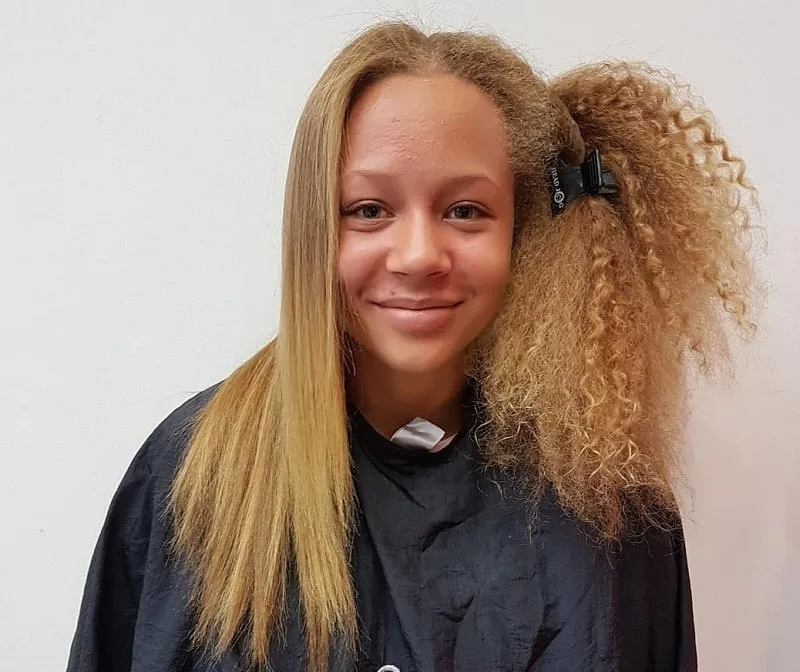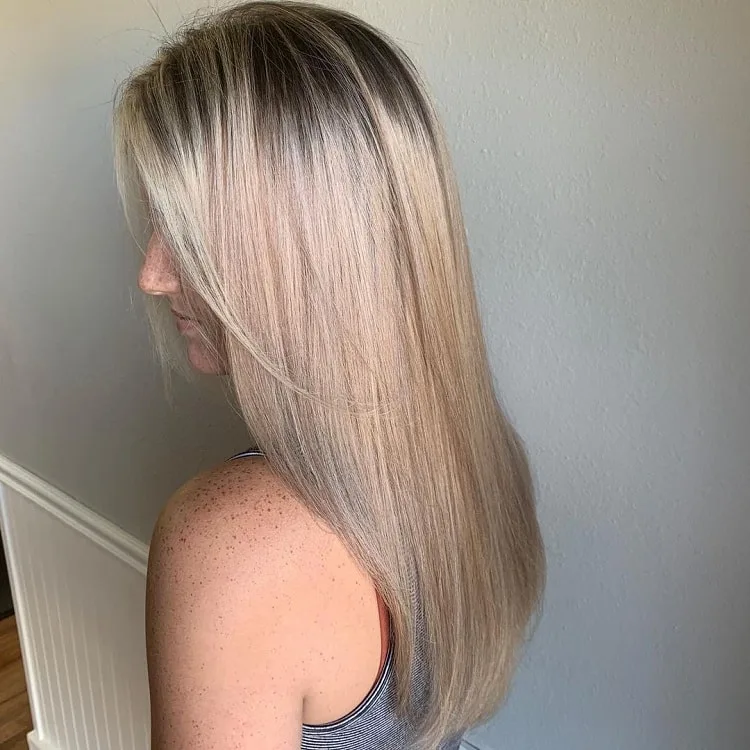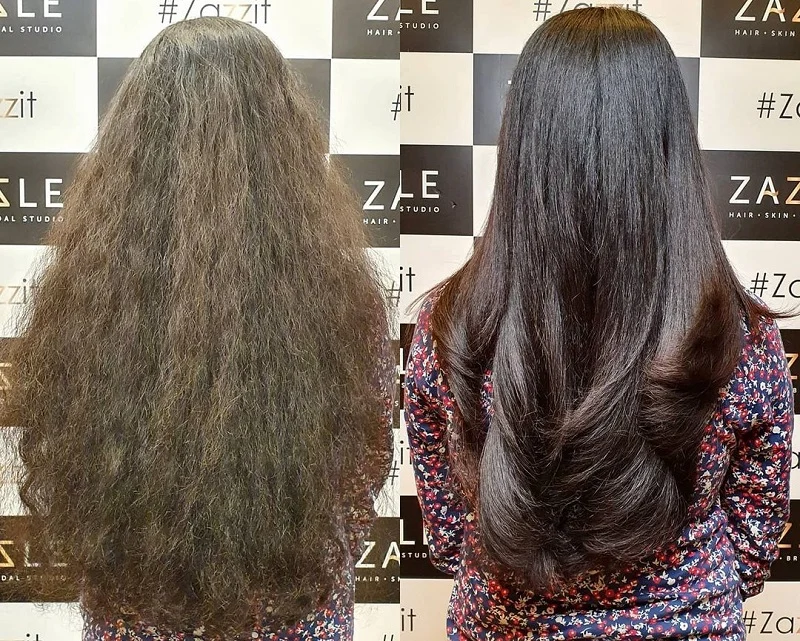How you decide to straighten your hair is an important decision. Most beauty salons will offer several methods for getting permanent and semi-permanent straight hair.
Two of the most popular ways to get permanent or long-lasting straight hair are the Japanese hair straightening and Brazilian blowout methods
However, if you’re going to undergo one of these dramatic chemical changes to your natural hair, you need to choose one that is reliable and suits you and your look.
Each of these methods has its advantages. We will analyze both Japanese hair straightening vs Brazilian blowout to find which is the overall best choice for a hair straightening treatment.
Japanese Hair Straightening

Japanese hair straightening, also known as “thermal reconditioning,” started in Japan in the 1990s. It was invented by Yuko Yamashita, a stylist and founder of the brand Yuko.
This process involves a chemical treatment that breaks down the hair’s natural structure, followed by a heat application that restructures the hair, resulting in permanently straight hair.
Women kept coming into her salon and complaining about how unruly and hard to control their hair was. So, Yuko developed a system that can permanently turn wavy, rough, or curly hair perfectly straight.
Japanese hair straightening can eliminate 70% to 90% of curls/frizz. To have Japanese hair straightening done in a professional salon can cost between $450 to $800.
This is typically based on an hourly rate for the entire process, which takes about five hours. After the procedure is complete, you’ll have straight hair for up to six months.
Process of Japanese Hair Straightening:
First, they apply a solution to your hair to break down molecular bonds to make it softer and straighter.
Then the stylist will rinse out your hair, give it a blow-dry, then flat iron your hair to really trap in the chemical process.
Afterward, they will add a neutralizer to repair the molecular bonds and pH levels. After another rinse, blow-dry, and flat iron, you will have permanently straight hair.
Pros and Cons of Japanese Hair Straightening

Considering the pros and cons is crucial before deciding to undergo Japanese hair straightening. So take a look at the benefits and drawbacks:
Pros:
- One of the biggest advantages is its permanence. The hair remains straight until it grows out. It makes hair more manageable, especially for those with frizzy, curly, or unruly hair.
- It provides a very sleek, smooth, and shiny finish, which is often more difficult to achieve with other straightening methods.
- Once your hair is treated, daily styling time is significantly reduced. You won’t need to spend much time blow-drying or straightening your hair.
- It’s effective on a wide variety of hair types, including very curly or coarse hair.
Cons:
- The chemicals and heat used in the process can cause significant damage, particularly to already weakened or previously chemically treated hair.
- As it’s a permanent treatment, any mistakes or dissatisfaction with the results can be difficult to reverse. Once your hair is straightened, you lose the ability to style it in ways that require natural curls or waves.
- As new hair grows, it will maintain its natural texture. This necessitates regular touch-ups.
- The process can be expensive and time-consuming, often requiring several hours in the salon.
- It’s not recommended for people with severely damaged hair or hair that has been over-processed with other chemicals.
Brazilian Blowout

A Brazilian Blowout is a hair-smoothing treatment used to reduce frizz and improve the shine of hair. It has been a popular hair straightening method since the early ’80s.
Ribiero Paulo, Kathy Ireland’s (a well known supermodel) hairstylist, invented the process in Aguas de Lindoia, Brazil. He created it to keep a model’s hair straight throughout a week-long photoshoot.
The method was seen as innovative because it didn’t leave a line and looked more natural. It also prevented demarcation (curly hairs regrowing and mixing with straight hair.
Brazilian blowouts have gained immense popularity in New York and Los Angeles for their practical and quick application.
Generally, a Brazilian blowout will last 10 to 12 weeks and take 45 minutes to apply. In a professional salon, it will cost between $200 to $500.
Process of Brazilian Blowout:
The treatment is based on liquid keratin, which is used in most hair straightening treatments. It bonds to hair and coats it to protect from damage.
After the keratin, your hair will be blow-dried, straightened, rinsed, and then blow-dried a second time.
The heat from the flat iron will activate the bonds between the chemicals and your hair.
Since the process is native to Brazil, it involves several ingredients found within the country. A Brazilian blowout solution will also contain camu camu, acai berry, and annatto seed.
Applying the acai berry as a maintenance product will make the blowout last longer. The straightness can vary from slightly to entirely based on how long the stylist flat irons your hair.
Pros and Cons of Brazilian Blowout

The Brazilian Blowout is a popular hair smoothing treatment, but like any straightening procedure, it has its pros and cons:
Pros:
- It effectively reduces frizz, leaving hair smoother, shinier, and more manageable.
- Works well on various hair types, including curly, frizzy, and coarse hair.
- Post-treatment, hair is easier and quicker to style. Blow-drying and straightening take much less time.
- Unlike some treatments, you don’t have to wait several days before washing your hair or styling it as you like.
- The treatment can be tailored to keep your natural texture while removing frizz or to achieve a sleeker, straighter look.
- It can improve the appearance of damaged hair, adding a healthy-looking shine and smoothness.
Cons:
- Brazilian Blowouts involve chemicals like formaldehyde (or formaldehyde-releasing ingredients), which can be harmful and may release potentially toxic fumes during the treatment.
- The effects typically last about 3-4 months, depending on hair type and maintenance, requiring regular treatments to maintain the look.
- It can be expensive, with costs varying depending on the salon and hair length/thickness.
- While it can make hair appear healthier, the chemicals and heat used during the process can potentially damage the hair.
- It’s not recommended for people with severely damaged hair or women who are pregnant or breastfeeding due to the chemicals used.
- Specific sulfate-free hair care products are recommended to maintain the treatment’s effects, which can add to the overall cost.
Japanese Hair Straightening Vs. Brazilian Blowout
Now that we understand how both processes work, let’s take a look at the differences between Brazilian blowout and Japanese hair straightening:
Nature of Results
The chemical reactions during Japanese hair straightening are intense and will keep your hair straight for months.
While Brazilian Blowouts are effective and will make your hair easier to manage, they don’t last nearly as long as the Japanese method.
Manageability
If you like to keep your hair straight and are tired of visiting the salon or spending hours working on it yourself, then Japanese straightening could be the right method for you.
The long-lasting treatment will free up your time to focus on other parts of your look and look great after a quick brushing in the morning.
Hair Texture Post-Treatment
Japanese straightening results in hair that is permanently straight. The process is designed to eliminate curls and waves completely, offering a consistently straight appearance.
Brazilian blowout softens and smooths the hair while retaining some of the hair’s natural texture and volume. It’s more about reducing frizz and enhancing manageability rather than achieving stick-straight hair.
Chemical Intensity
Japanese hair straightening involves the use of stronger chemicals to break down the hair’s natural bonds and reform them. This intense chemical process can be damaging, especially to already weak or damaged hair.
Brazilian blowout also uses chemicals, but they are generally less harsh than those used in Japanese straightening. The primary aim is to coat the hair with a protective layer rather than altering its structure.
Versatility
Japanese straightening offers less styling flexibility. Since the hair is permanently straightened, you lose the ability to style it in ways that require curls or waves.
Brazilian blowout provides more styling flexibility. You can enjoy smoother hair but still have the option to style it with waves or curls, as the natural texture is not completely eliminated.
Maintenance and Upkeep
Japanese hair straightening requires regular touch-ups for the new hair growth at the roots, as the rest of the hair remains permanently straight. These touch-ups can be necessary every few months, depending on hair growth rate.
Brazilian blowout is Easier in terms of maintenance. As the effect fades gradually, there’s no distinct line between treated and new hair, and maintenance doesn’t require precise timing. Regular treatment can be done every 3-4 months to maintain the smooth texture.
So, Japanese Hair Straightening or Brazilian Blowout: Which Is Better?
Japanese Hair Straightening offers long-lasting results and reduces the need for daily hair maintenance.
However, it has a long recovery time, requiring about three days before you can wash your hair or change your hairstyle, as any alterations could impact the straightening effect.
Moreover, it’s not entirely permanent, as touch-ups are necessary every six months or upon new hair growth.
This method is ideal for those seeking a permanent straightening solution and are willing to accommodate the maintenance and recovery time.
Brazilian Blowouts, on the other hand, are quicker and less permanent. The treatment takes only about 45 minutes, making it a convenient choice for those with limited time.
It’s also less of a commitment, as the natural curls return in about 10 to 12 weeks.
When choosing between the two, consider factors such as the desired longevity of the treatment, time commitment, and financial investment.
If you prefer a permanent solution and don’t mind the longer process and recovery time, Japanese hair straightening is the way to go.
However, if you seek a quick, less permanent solution and are okay with regular salon visits, a Brazilian blowout would be more appropriate.
Considering all these factors, we think Brazilian blowout is better than Japanese straightening as you don’t have to commit to it and it offers more versatility and less damage to your hair.
